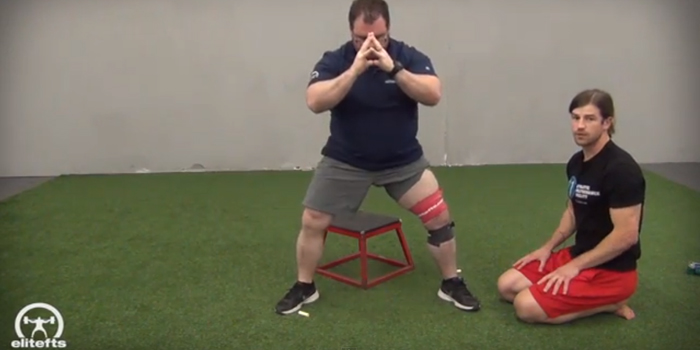
Elitefts™ Director of Education Mark Watts visits with Ben Van Treese of 11athletics in Columbus, Ohio. Van Treese explains three different mobility drills to help increase the range of motion and decrease hip and knee pain in the squat as Watts uncomfortably demonstrates.
These drills combine static stretching, myofascial release techniques, and compression to increase mobility in the ankle, thoracic spine, and hips while improving blood-flow and tracking around the knee joint.
Mobilizations and Compressions
- Ankle Mobility to improve dorsi-flexion and plantar-flexion
- Couch Stretch to improve Hip-Flexion
- Mobility Ball soft-tissue work for the T-Spine
- Compression above and below the knee joint.
Lacrosse balls are not just for playing lacrosse. In fact, I've never played lacrosse in my life...if I'm going to tear my body up, I figured the most fun I'll have is in a squat rack. My aerobic capacity just isn't good enough to be a LAX brah. You really can tell by the bloat in my hand.
We're missing the point. This little tool is made from a bulletproof (not literally) rubber composite and emblazoned with the elitefts™ logo one at a time by Americans who take pride in offering an awesome product to help work out the knots and dig into your favorite (worst) trigger points. Simply put, this thing can help you be a better lifter and athlete.
Use one. This thing is great to hit the glutes on squat day, and the upper back on bench day. It's actually great to hit either one on either day because, as you know, all our powerlifts are really full-body movements if you're doing them correctly.
The options are limitless. Taping two together doubles your fun and gives you even more options for self-mysofascial release and trigger point therapy around the T-spine and more.
Stay tuned for more complementary content to take your warmups and recovery to the next level.
Elitefts™ Pro Average Compression Floss Band
Elitefts™ Pro Strong Compression Floss Band
Muscular compression cemented its place in recovery protocols years ago, but now we’ve found a better form of tight wrap: Pro Compression Floss Bands.
The use of Pro Compression Floss Bands has been reported to alleviate pain around achy muscles, joints, and tendons through short and long-term applications. Many athletes and competitive lifters have used the Pro Compression Floss Bands to facilitate proper motor patterns, mend biomechanical positioning, and prepare for the demanding rigors of intense training.
How to Use the Pro Compression Floss Bands:
The possible applications of the Pro Compression Floss Bands are endless. The most common methods include wrapping an achy or non-responsive muscular-joint area and spending several minutes performing motions that target the afflicted area. For instance, to aid a nagging knee, an athlete may use a Pro Compression Floss band to tightly wrap above and below the knee. Then, by performing bodyweight squats for several minutes, the tissue surrounding the knee becomes less bothersome and opens up the range of motion for safer, optimal training conditions.
The tightness of the wrap can be altered based on individual tolerance and severity of ailments. You can use the Pro Compression Floss Bands almost anywhere:
• Forearms
• Biceps
• Elbows
• Shoulders
• Calves
• Knees
• Hamstrings
• Hip
• Groin
For safety reasons, the Pro Compression Floss Bands should be removed if a limb begins to feel numb or becomes pale. End user assumes all risk associated with the use of this product. Consult a medical professional before use.








